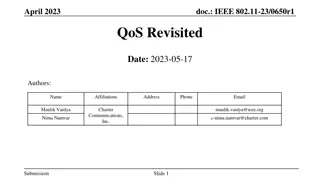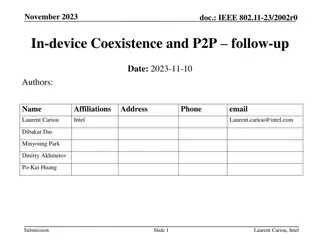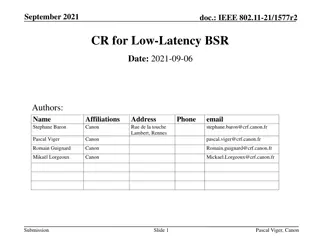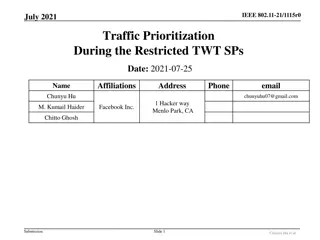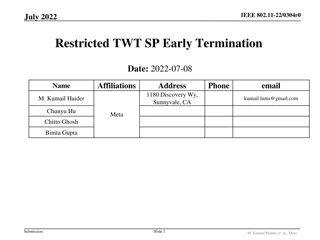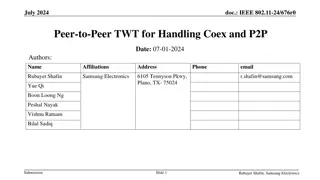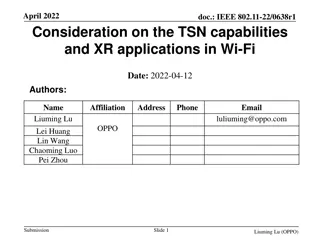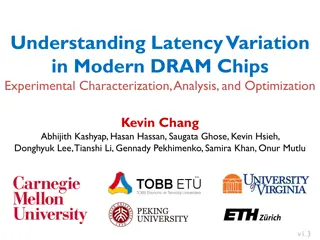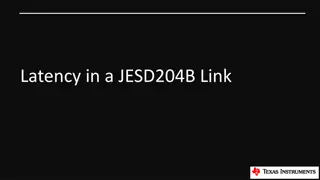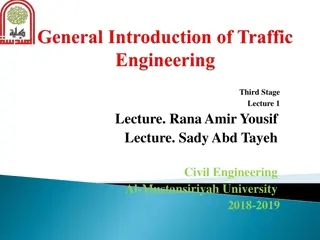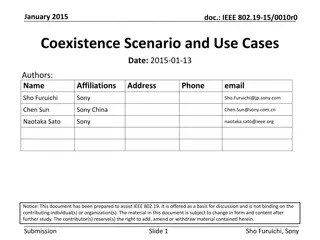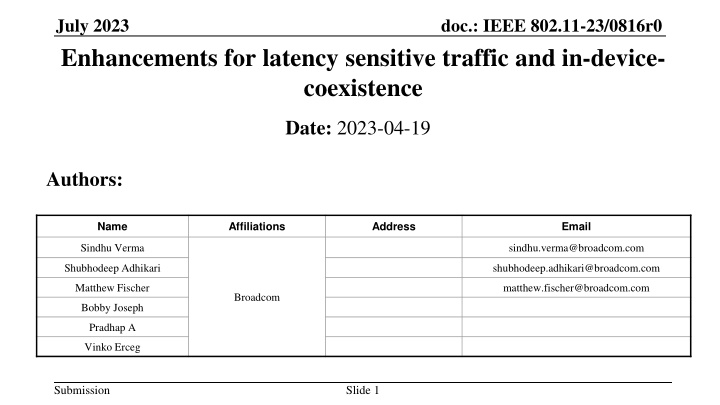
July 2023 Enhancements for Latency-Sensitive Traffic and In-Device Coexistence
Explore enhancements proposed in the IEEE 802.11-23/0816r0 document for improving performance in latency-sensitive traffic scenarios, multi-link operations, and in-device coexistence. The document discusses mechanisms such as AMPDU-BA enhancements, TXOP adjustments, and traffic parameter modifications to address limitations in the current BA mechanism and improve link adaptation. Dive into informed delayed BA mechanisms, enhanced TXOP/PPDU/AMPDU structures, and dynamic burst duration adjustments to optimize performance further.
Download Presentation

Please find below an Image/Link to download the presentation.
The content on the website is provided AS IS for your information and personal use only. It may not be sold, licensed, or shared on other websites without obtaining consent from the author. If you encounter any issues during the download, it is possible that the publisher has removed the file from their server.
You are allowed to download the files provided on this website for personal or commercial use, subject to the condition that they are used lawfully. All files are the property of their respective owners.
The content on the website is provided AS IS for your information and personal use only. It may not be sold, licensed, or shared on other websites without obtaining consent from the author.
E N D
Presentation Transcript
July 2023 Enhancements for latency sensitive traffic and in-device- coexistence doc.: IEEE 802.11-23/0816r0 Date: 2023-04-19 Authors: Name Affiliations Address Email Sindhu Verma sindhu.verma@broadcom.com Shubhodeep Adhikari shubhodeep.adhikari@broadcom.com Matthew Fischer matthew.fischer@broadcom.com Broadcom Bobby Joseph Pradhap A Vinko Erceg Submission Slide 1
July 2023 doc.: IEEE 802.11-23/0816r0 Abstract This contribution discusses possible enhancements to achieve improvements in performance in the context of latency sensitive traffic, multi-link operation, link adaptation and in-device-coexistence. It discusses different mechanisms to achieve this: Enhancements to the existing AMPDU-BA mechanism and TXOP structure for more efficient multi-link operations, latency reduction, link adaptation and in-device-coexistence Adjustment of traffic parameters and TXOP for better in-device- coexistence Submission Slide 2
July 2023 doc.: IEEE 802.11-23/0816r0 Overview Limitations of the current immediate BA mechanism Limitations of the current TXOP/PPDU/AMPDU structure Lack of recipient s control over burst durations Proposal 1: Informed delayed BA mechanism Proposal 2: Enhanced TXOP/PPDU/AMPDU structure Proposal 3: Semi-static adjustment of burst durations Proposal 4: Dynamic adjustment of burst durations Submission Slide 3
July 2023 Limitations of the current immediate BA mechanism (1) doc.: IEEE 802.11-23/0816r0 1. Processing constraints at the recipient When an AMPDU recipient is required to respond with BA at SIFS after the eliciting AMPDU s PPDU, the recipient might be incapable of doing so due to internal processing limitations (e.g. processing delay beyond SIFS, based on MCS/byte count/MPDU count, etc). Such constraints may make it incapable of receiving later MPDUs within a long AMPDU Minimum MPDU Start Spacing is a parameter to take care of processing constraints. However, It specifies the minimum spacing between any 2 MPDUs in microseconds irrespective of the MCS/bandwidth/MIMO order, etc used. The spacing needs to be guaranteed even through padding which wastes transmission resources. It is desirable if the solution gets exercised only if the specified maximum MPDU count/MPDU byte count etc are exceeded at the recipient and without wastage of resources. Submission Slide 4
July 2023 Limitations of the current immediate BA mechanism (2) doc.: IEEE 802.11-23/0816r0 2. In-device Coexistence constraints at the recipient When an AMPDU recipient is required to respond with BA at SIFS after the eliciting AMPDU s PPDU, the recipient might be incapable of doing so due to an upcoming burst of activity on another in-device technology like Bluetooth/UWB/LTE/NR which would prevent it from receiving the later MPDUs or transmitting the BA due to in-device interference. 3. Handling of NSTR clients at the AP To avoid UL transmission from the recipient that may cause destructive interference to recipient s ongoing reception on another link, the originator can perform consecutive DL transmissions to multiple recipients and then trigger BA in an MU fashion instead of using immediate BA 4. Link Adaptation Convergence Multiple MCSs/NSSs cannot be tried together and each combination must be tried one at a time followed by a corresponding feedback. Convergence of the link adaptation algorithm can be made faster if a composite feedback can be obtained for multiple MCSs/NSSs and only when the originator desires. Having mandatory intermediate BA reduces efficiency. Submission Slide 5
July 2023 Limitations of the current TXOP/PPDU/AMPDU structure (1) doc.: IEEE 802.11-23/0816r0 1. Lack of time margin in MLO for AMPDU construction The MLD may be prepared to transmit AMPDUs simultaneously on both the links and may have prepared transmissions accordingly with different sequence number sets. However, if one of the links wins access first or if the other link becomes busy, the earlier sequence numbers would preferably need to be transmitted on the winning link especially in case of an NSTR/EMLSR MLD. If the bandwidth for which access to any link is won, is different from what was assumed while preparing disjoint sets of transmissions for the two links, the AMPDU contents may need to be assembled again. Transmitting without rebuilding in some cases may cause unnecessary retransmission of MPDUs or transmission of MPDUs with unnecessary gaps in sequence numbers. An STR MLD which wants to align PPDUs on 2 links, may be waiting to decode length information of a transmission from an NSTR ML device on one of the links (say link1) while it wins access to the other link (say link2). If the STR MLD does not align the end of its link2 transmission with the end of its link1 reception, the NSTR ML device having missed the link2 preamble, may collide with the link2 transmission. Submission Slide 6
July 2023 Limitations of the current TXOP/PPDU/AMPDU structure (2) doc.: IEEE 802.11-23/0816r0 2. In MLO, events on a link 1 might impact decisions regarding transmissions on a link 2. For e.g. the MLD might receive BA correctly on link 1 but not on link 2, and in an asynchronous manner. In this case, the transmitter MLD may want the flexibility to prioritize retransmissions of erroneous packets from link 2 even though link 1 transmission started earlier than the end of link 2 transmission. 3. In MLO and in case of NSTR ML recipients, PPDUs on the two links may need to be aligned so that UL transmission of BA on one link is not destructive to reception on another link. 4. The LENGTH and contents of an AMPDU cannot be adjusted once the transmission of a PPDU starts, as LENGTH is contained in the L-SIG. Submission Slide 7
July 2023 Limitations of the current TXOP/PPDU/AMPDU structure (3) doc.: IEEE 802.11-23/0816r0 5. Handling of latency sensitive transmissions If latency-sensitive traffic arrives newly, it needs to wait for the end of an ongoing transmission burst/TXOP before it can be transmitted. AMPDUs are typically constructed as long as feasible, since longer AMPDUs increase MAC efficiency by omitting intermediate PHY header/SIFS/BA. 6. For long AMPDUs, if the initial PHY header is missed, decoding fails for the receiving device and preamble detection fails for any device performing CCA The problem is especially pronounced in case of hidden nodes, fading channels and blindness in NSTR/EMLSR ML devices. 7. Link adaptation convergence Multiple MCSs/NSSs cannot be tried together and each combination must be tried one at a time followed by a corresponding feedback Submission Slide 8
July 2023 Lack of recipient s control over burst durations (1) doc.: IEEE 802.11-23/0816r0 In-device-coexistence (IDC) is significantly impacted by lack of control over long bursts of transmissions from the AP or triggered by the AP to the recipient. In IDC scenarios with 802.11 and Bluetooth/UWB, there are certain cases where continuous 802.11 medium availability is limited to a few milliseconds. For example, depending on the Bluetooth profile, the medium availability for 802.11 could be: 2.5ms every 3.75ms, OR 6.25ms every 7.5ms, OR 8.5ms every 11ms etc. A long receive packet or a burst of RX packets has a high chance of crossing 802.11 medium boundaries and getting curtailed by Bluetooth So, this requires the Rx packet duration to be reduced in order to fit the medium availability at 802.11 (outside of Bluetooth slots or any other coexisting device). At present, coexistence between 802.11 and Bluetooth/UWB/LTE is mostly handled in a proprietary manner. Submission
July 2023 Lack of recipient s control over burst durations (2) doc.: IEEE 802.11-23/0816r0 Some non-standardized implementations may overload existing functionalities to indirectly control the time duration of the Rx/Tx packet. For Downlink, one can reduce AMPDU aggregation, even turn off AMPDU/AMSDU aggregation altogether or reduce the maximum length in bytes. This causes suboptimal performance without addressing the actual problem. Even upon turning off aggregation, there is no means to control the duration of a single MSDU which can be long enough to spill into the desired inactivity period. For Uplink, one can disable triggered mode of operation, which also disables Uplink OFDMA. This is again suboptimal. Coexistence between 802.11 and BT/UWB can be improved if there are standardardized mechanisms to support coexistence. The same mechanisms can be used to solve other issues of in-device-coexistence such as coexistence between 802.11 and LTE/NR. They can also be used to optimize performance in case of any activity that results in temporary inability to receive/transmit 802.11 frames Submission
July 2023 doc.: IEEE 802.11-23/0816r0 Proposal 1: Informed delayed BA mechanism (1) AMPDU Recipient indicates its limitations to AMPDU originator Maximum MPDU count, maximum byte count, maximum duration of the AMPDU to be able to transmit BA at SIFS Minimum delay, maximum delay for BA transmission In device-coexistence issues if they exist. AMPDU Originator allows for delayed BA response If the AMPDU originator follows the recipient s limitations e.g. transmits AMPDUs which fall below the RX-TX delay limits, and recipient has not signaled that coexistence issues are present AMPDU originator interprets lack of BA at SIFS as failure Otherwise, AMPDU originator interprets lack of BA as delayed BA Submission Slide 11
July 2023 doc.: IEEE 802.11-23/0816r0 Proposal 1: Informed delayed BA mechanism (2) If the AMPDU originator interprets lack of BA as delayed BA It assumes that the missing BA will be transmitted by the recipient after a negotiated minimum delay X and before a maximum delay Y, either using contention OR triggered by a BAR The expiry of maximum delay will lead to the assumption at the originator that the AMPDU is in error It optionally continues with its TXOP (i.e. after PIFS) transmitting the next PPDU to same recipient or other recipient(s) AMPDU recipient exercising delayed BA If the recipient transmits BA within SIFS, the BA indicates the last processed sequence number of the AMPDU (<=last sequence number in the AMPDU) . Else when transmitted, the BA should be cumulative in terms of ACK information e.g. if additional AMPDUs arrive before BA is transmitted Submission Slide 12
July 2023 doc.: IEEE 802.11-23/0816r0 Proposal 1: Informed delayed BA mechanism (3) The originator may not desire BA after SIFS because: It intends to send sequence of AMPDUs (with no gaps or SIFS gap) E.g. for handling latency sensitive traffic, MCS exploration for link adaptation, improving decoding/CCA (details later) There are known recipient limitations vs AMPDU contents E.g. AMPDU exceeds recipient maximum byte count In this case: The originator indicates a provision/desire for delayed BA (to a recipient that indicates capability) E.g. indication in PHY header or MAC header After signaling, the originator is free to transmit again after SIFS or even without any gap The originator will elicit a BA later e.g. using Implicit BAR / Explicit BAR Optionally allows the recipient to initiate BA transmission e.g. within the recipient s own TXOP The difference between the existing delayed BA procedure and this proposal is that this proposal allows dynamic per-burst behaviour regarding the choice of BA (i.e. whether immediate or delayed) while the existing procedure forces the BA for every burst to be a delayed BA once the BA agreement is setup. Submission Slide 13
July 2023 Proposal 2: Enhanced TXOP/PPDU/AMPDU structure (1) doc.: IEEE 802.11-23/0816r0 A short PPDU (AMPDU) could precede a longer PPDU (AMPDU) with either SIFS gap or no gap in between. Inserting SIFS+BA+SIFS between the two AMPDUs would lead to wastage. It might also cause a problem with synchronous MLD receivers. It helps if there is flexibility to insert a small PPDU in the beginning after which the PPDU with desired final length and contents can occur. This has the following advantages: A time margin for the AMPDU originator to build/rebuild AMPDUs based on the link that wins channel access and the bandwidth with which it wins channel access or while waiting to decode length information for the purpose of alignment An option for the AMPDU originator to react to asynchronous events on the multiple links of the MLD. So, the MLD could tentatively use a small PPDU at the beginning of link 1 transmission and follow it up with a larger PPDU depending on the ACK status on link 2. Submission Slide 14
July 2023 Proposal 2: Enhanced TXOP/PPDU/AMPDU structure (2) doc.: IEEE 802.11-23/0816r0 Handling latency-sensitive traffic Allowing multiple PPDUs with SIFS gap or no gap in between can also help better prioritize latency sensitive traffic and hence reduce latency For example, this can enable the insertion of latency sensitive traffic in an ongoing transmission, rather than wait for the end of the ongoing transmission burst/TXOP When low-latency packets are anticipated, long PPDUs in a TXOP can be broken into a sequence of shorter PPDUs to allow insertion of low latency traffic Submission Slide 15
July 2023 Proposal 2: Enhanced TXOP/PPDU/AMPDU structure (3) doc.: IEEE 802.11-23/0816r0 Decoding/CCA failure for long AMPDUs/PPDUs The problem can be alleviated if instead of a long PPDU, a sequence of shorter back-to- back PPDUs without gaps or with SIFS gap can be transmitted followed by a single composite BA. Even if any intermediate PPDUs are in error, the remaining can be decoded This will result in better throughput at the receiver in case of fading/dynamic channels. This will also help collision avoidance through preamble detection especially in case of blindness in NSTR/EMLSR ML devices, since such a device will get to decode multiple preambles instead of only one for the same amount of data transmission and without the overhead of repeated SIFS+BA Submission Slide 16
July 2023 Proposal 2: Enhanced TXOP/PPDU/AMPDU structure (4) doc.: IEEE 802.11-23/0816r0 Link Adaptation Convergence Convergence of the link adaptation algorithm can be made faster if a composite feedback can be obtained for a back-to-back PPDU (AMPDU) sequence with multiple MCSs/NSSs. The transmitter can pack back-to-back PPDUs each with a different MCS/NSS combination without any gap or with SIFS gap. At the end of the burst, a composite BA is elicited which helps the transmitter know which MCS/NSS combination was the most successful. Not having intermediate BA (and SIFS) helps increase efficiency. Flexibility for NSTR ML recipients To avoid UL transmission from the recipient that may cause destructive interference to recipient s ongoing reception on another link, the originator can perform consecutive DL transmissions to multiple recipients and then trigger BA in an MU fashion. The originator indicates this (absence of immediate immediate BA and the back-to-back structure) dynamically in the PHY or MAC header. This provides much higher flexibility than setting Ack Policy = Block Ack (within the HT-immediate context), as the latter provision means that none of the AMPDUs can be acknowledged with an immediate BA and have to be instead acknowledged with a BAR-SIFS-BA combination. Slide 17 Submission
July 2023 doc.: IEEE 802.11-23/0816r0 Proposal 3: Semi-static Adjustment of traffic parameters without re-association (1) It is desirable to have a semi-static limit on the time duration of a burst to/from the concerned non- AP irrespective of the number of bytes or the extent of MSDU/MPDU aggregation A new action frame can be defined for semi-statically changing the Downlink burst duration that can be supported by the non-AP in a coex environment. Similar procedure can also be used to semi-statically adjust the duration limit for triggered Uplink. This will obviate the need to disable triggered uplink altogether. In addition to Downlink/Uplink burst duration, it may also be beneficial to indicate the desired periodicity of Downlink/Uplink activity. For example, it can be preferred by a non-AP to have a burst duration of up to x ms in every y ms so that at least (y-x) ms is available every y ms for non- 802.11 operations The supported burst parameter will be per-link/per-channel/per-band basis, as each link/channel/band can have different in-device coexistence issues (with respect to different technologies like BT/UWB/LTE/LAA/NR/NR-U). Submission Slide 18
July 2023 doc.: IEEE 802.11-23/0816r0 Proposal 3: Semi-static Adjustment of traffic parameters without re-association (2) Below is an illustration of a negotiated burst limit of x ms and every y ms. Submission Slide 19
July 2023 doc.: IEEE 802.11-23/0816r0 Proposal 4: Dynamic Adjustment of burst duration (1) The device with an IDC constraint can dynamically request to reduce the remaining burst duration Preferred remaining burst duration can be indicated through CTS or BA in response to a Downlink transmission. For example, CTS: The initial TXOP duration is contained in the RTS and the responder that has an IDC constraint suggests how much of remaining TXOP duration it prefers resulting in dynamic reduction of the TXOP BA: The transmission starts with a shorter DL burst and in the BA, the responder suggests the remaining TXOP duration Preferred remaining burst duration can be indicated in an Uplink packet transmitted in response to a trigger frame The remaining burst duration can be used either for Downlink transmission to this device or Uplink transmissions from this device that is facing an IDC constraint. It may also be beneficial to indicate the desired inactivity time after completion of the current burst. This will serve as a notice of absence. Slide 20 Submission
July 2023 doc.: IEEE 802.11-23/0816r0 Proposal 4: Dynamic Adjustment of burst duration (2) Below is an illustration of dynamic adjustment of burst duration and inactivity period Here, the preferred remaining burst duration and the time until the preferred next start of 802.11 activity are indicated using a BA in response to an AMPDU In the same way, these parameters can be indicated in a CTS in response to an RTS and in a TB PPDU in response to a trigger frame Additional considerations If the remaining burst duration is reduced after the medium is reserved for a longer duration using RTS, there can be unused reserved air time left after the end of the burst to the particular non-AP. This can result in potential unfairness However, in that case, CF-end can be used by the AP in order to make this remaining duration available to other devices on the channel. The AP can also use this remaining reserved time for other exchanges (i.e. with other non-APs) Submission Slide 21
July 2023 doc.: IEEE 802.11-23/0816r0 Straw Poll 1 Do you support the inclusion of the following in the SFD: 802.11bn AMPDU-BA exchange mechanism allows for the following enhancements: Recipient indication of constraints regarding immediate BA transmission Maximum MPDU count, maximum byte count of AMPDU to meet SIFS response time for BA transmission Minimum delay, maximum delay for BA transmission In-device coexistence issues Originator indication within a PPDU that a BA transmission at SIFS after the PPDU is not permitted. Y/N/A Submission Slide 22
July 2023 doc.: IEEE 802.11-23/0816r0 Straw Poll 2 Do you support the inclusion of the following in the SFD: 802.11bn AMPDU-BA exchange mechanism allows for the following enhancement: Transmission by the AMPDU originator of PPDUs without any intervening gaps or with SIFS gap, where each PPDU is allowed to have different MCS/NSS/duration. Y/N/A Submission Slide 23
July 2023 doc.: IEEE 802.11-23/0816r0 Straw Poll 3 Do you support the inclusion of the following in the SFD: A new action frame for semi-statically changing the Downlink/Uplink burst duration that can be supported by the non-AP in a coex environment. In addition to the burst duration, the preferred periodicity of the burst can also be indicated The supported burst parameter can be per-link/per-channel/per-band Y/N/A Submission Slide 24
July 2023 doc.: IEEE 802.11-23/0816r0 Straw Poll 4 Do you support the inclusion of the following in the SFD: Support for a mechanism or a field to dynamically indicate the remaining desired Downlink/Uplink burst duration immediately after the current transmission by the non- AP that can be supported by it in a coex environment. The field can be included in a CTS, BA or a TB PPDU In addition to the remaining burst duration, the preferred next occurence of the burst can also be indicated Y/N/A Submission Slide 25

